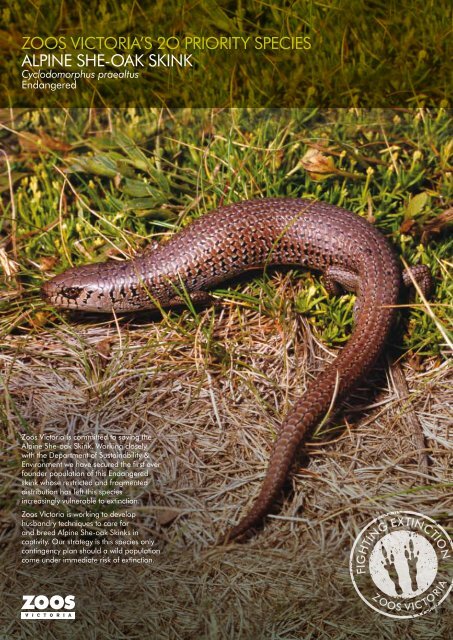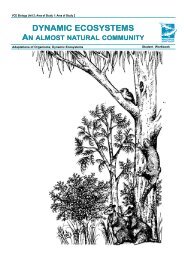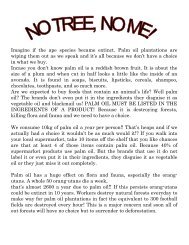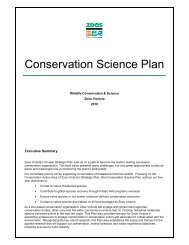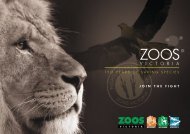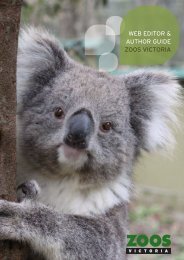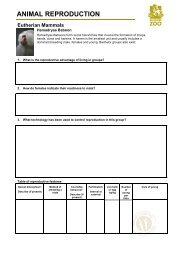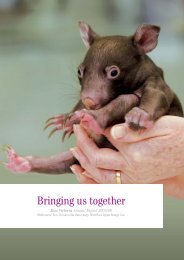ZOOS VICTORIA'S 2O PRIORITY SPECIES ALPINE SHE-OAK SKINK
ZOOS VICTORIA'S 2O PRIORITY SPECIES ALPINE SHE-OAK SKINK
ZOOS VICTORIA'S 2O PRIORITY SPECIES ALPINE SHE-OAK SKINK
Create successful ePaper yourself
Turn your PDF publications into a flip-book with our unique Google optimized e-Paper software.
<strong>ZOOS</strong> VICTORIA’S <strong>2O</strong> <strong>PRIORITY</strong> <strong>SPECIES</strong><br />
<strong>ALPINE</strong> <strong>SHE</strong>-<strong>OAK</strong> <strong>SKINK</strong><br />
Cyclodomorphus praealtus<br />
Endangered<br />
Zoos Victoria is committed to saving the<br />
Alpine She-oak Skink. Working closely<br />
with the Department of Sustainability &<br />
Environment we have secured the first ever<br />
founder population of this Endangered<br />
skink whose restricted and fragmented<br />
distribution has left this species<br />
increasingly vulnerable to extinction.<br />
Zoos Victoria is working to develop<br />
husbandry techniques to care for<br />
and breed Alpine She-oak Skinks in<br />
captivity. Our strategy is this species only<br />
contingency plan should a wild population<br />
come under immediate risk of extinction.
Zoos Victoria is committed to Fighting Extinction<br />
We are working to ensure that no Victorian terrestrial vertebrate<br />
species goes extinct on our watch.<br />
The mountain habitats of the Alpine<br />
She-oak Skink are so isolated that<br />
they are sometimes described as<br />
‘sky islands’ – each mountain top<br />
is separated from the others by a<br />
‘sea’ of lower-altitude habitat that<br />
is unsuitable for these little skinks.<br />
Such isolation means that a single<br />
passing fire could devastate the<br />
population and make it difficult for<br />
any remaining skinks to survive. If<br />
there is a catastrophic disturbance<br />
to the skinks’ alpine habitat, Zoos<br />
Victoria will be ready to implement<br />
a recovery program and ensure the<br />
survival of this Endangered species.<br />
KEY PROGRAM OBJECTIVES<br />
+ Develop captive husbandry protocols and<br />
a breeding action plan<br />
+ Release captive-bred individuals to<br />
re-establish populations if necessary after<br />
a local extinction<br />
+ Maintain wild populations across their<br />
current range<br />
+ Raise community awareness of the Alpine<br />
She-oak Skink and the need to conserve<br />
alpine environments.<br />
PROGRAM OUTCOMES<br />
+ Permits for collection of Alpine She-oak<br />
Skinks have been obtained<br />
+ Twelve founder skinks have been secured<br />
and brought into captivity as of February<br />
2012.<br />
Alpine She-oak Skinks are being cared for<br />
and displayed at Healesville Sanctuary. Our<br />
reptile specialists are developing suitable<br />
husbandry and breeding techniques for this<br />
unique species as we continue to learn more<br />
about them.<br />
<strong>SPECIES</strong> AT RISK<br />
Little is known about the life-history of the<br />
Alpine She-oak Skink, but animals are<br />
thought to mature at 2-3 years of age, mate<br />
in late spring/early summer and give birth<br />
to 2-9 young in mid-late summer. Living<br />
in alpine environments covered in tussock<br />
grasses and heath, this species is often<br />
found under rocks across the landscape.<br />
Hibernating over winter, these little skinks<br />
are known to live for more than five years<br />
in the wild. When under threat, Alpine<br />
She-oak Skinks exhibit a snake-like defence<br />
behaviour. With slender bodies reaching up<br />
to 12cm in length, they tuck in their reduced<br />
limbs, rear their head up, hold out their<br />
tongue and flick the tip as a snake does.<br />
Due to its fragmented distribution across<br />
the high country, the Alpine She-oak Skink<br />
is particularly vulnerable to catastrophic<br />
disturbances such as bushfires. Being<br />
restricted to alpine environments, it is also<br />
likely to be severely affected by climate<br />
change. Other threats to the skinks include:<br />
+ Predation by feral species such as foxes<br />
+ Grazing and trampling by exotic<br />
herbivores such as feral horses and<br />
cattle.<br />
Zoos Victoria is committed to improving<br />
the long-term future of the Alpine She-oak<br />
Skink. By developing captive husbandry and<br />
breeding techniques, we are improving the<br />
chances of a successful recovery for this<br />
species in the event of an imminent threat to<br />
wild populations.<br />
PROGRAM PARTNERS<br />
Department of Sustainability<br />
and Environment<br />
www.dse.vic.gov.au<br />
IMAGES<br />
Front: The Alpine She-oak Skink lives in<br />
tussock grasses and heathland habitat on<br />
the Bogong High Plains.<br />
Photo: Steve Wilson.<br />
Below top: During the summer months<br />
surveys are conducted on the Alpine She-oak<br />
Skink using tile transects.<br />
Photo: Michelle Cooper.<br />
Below bottom: Some individuals have a<br />
distinct red underbelly, this sub-adult is<br />
exhibiting its snake-like defence behaviour.<br />
Photo: Andrew Griffiths.<br />
FIND OUT MORE<br />
www.zoo.org.au/conservation<br />
Zoos Victoria is a not-for-profit, zoo based conservation organisation.<br />
We are Fighting Extinction through our local and global conservation programs,<br />
research projects and community conservation campaigns. For more information<br />
on this or any other Zoos Victoria project, visit www.zoo.org.au/conservation<br />
Printed on 100% recycled paper


